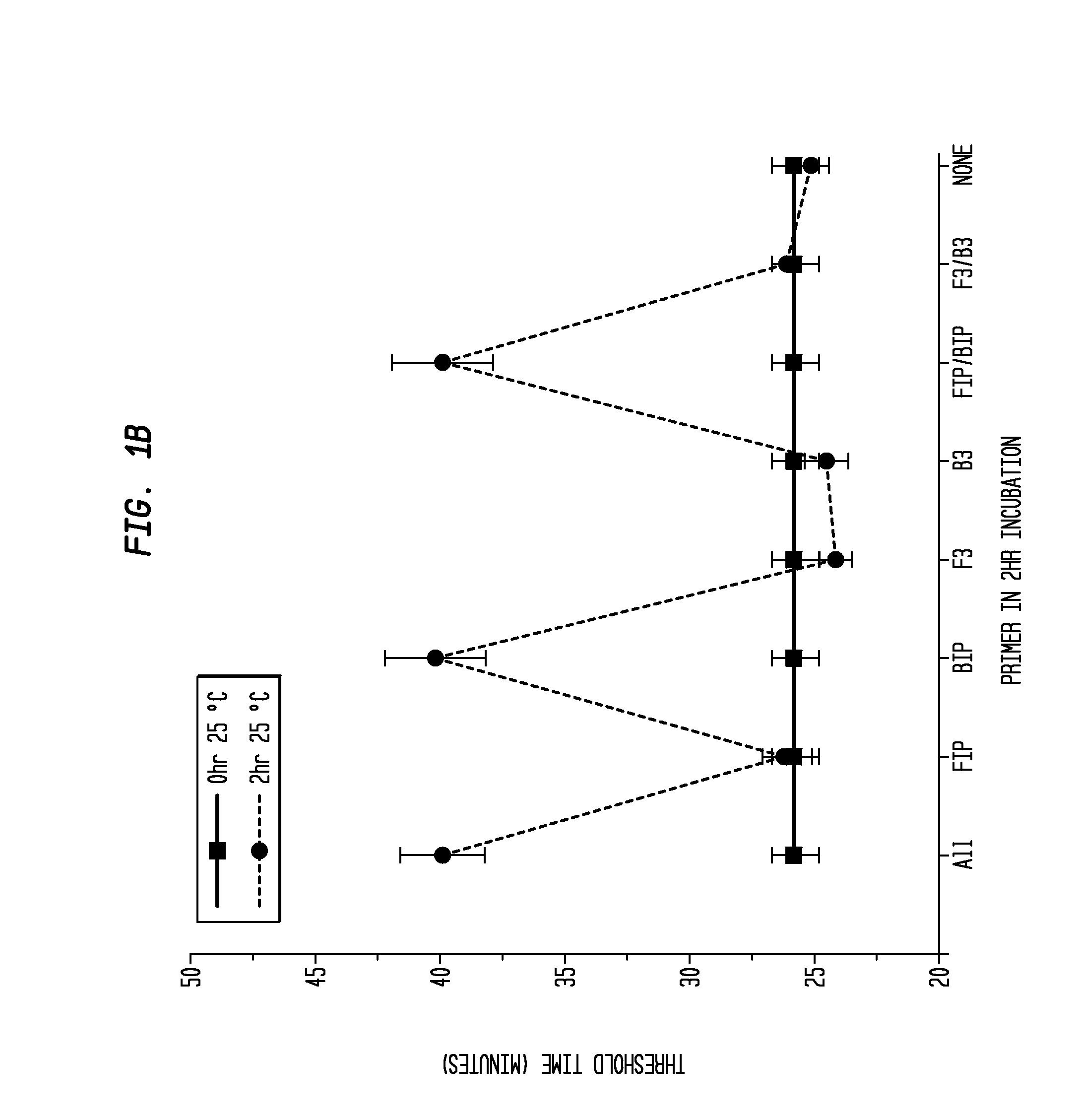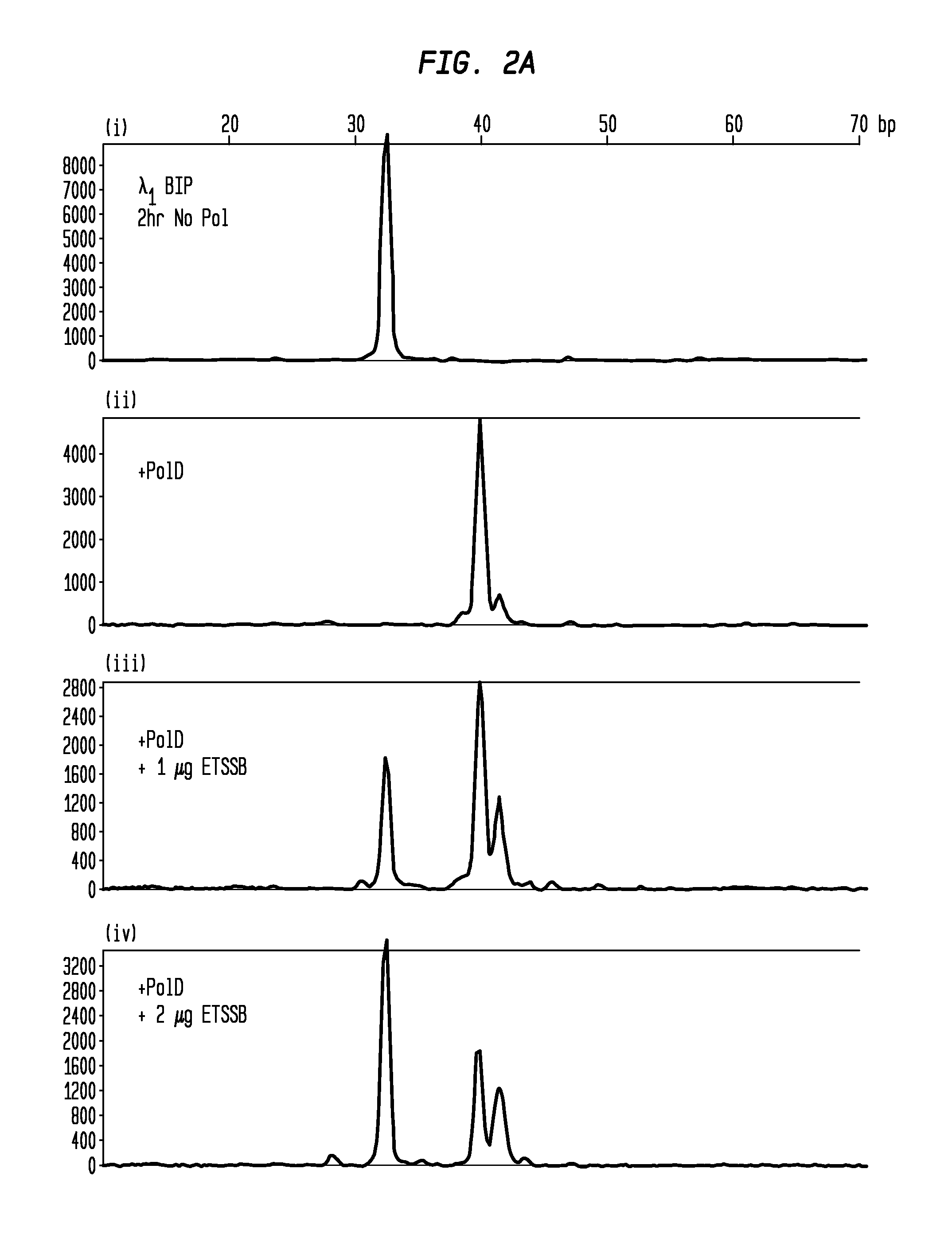Reducing template independent primer extension and threshold time for loop mediated isothermal amplification
a loop mediated isothermal and primer technology, applied in the field of reducing the extension of template independent primers and the threshold time of loop mediated isothermal amplification, can solve the problems of affecting the quality of the template, requiring a high level of consistency and accuracy, and often negatively affecting the high-throughput and diagnostic applications, so as to increase the rate of lamping, and improve the effect of template dna
- Summary
- Abstract
- Description
- Claims
- Application Information
AI Technical Summary
Benefits of technology
Problems solved by technology
Method used
Image
Examples
example 1
Determination of the Difference in Time to Reach Threshold Amplification Levels for Samples Pre-Incubated at RT Prior to Amplification with LAMP Primers in the Absence of SSB Compared with Samples that are Amplified without Pre-Incubation
[0044]LAMP reactions were performed at 65° C. either immediately or with indicated components incubated for 2 hours at 25° C. Reactions were performed in 25 μL volumes and consisted of 8 U Bst DNA Polymerase (New England Biolabs, Ipswich, Mass.), 5 ng λ DNA (New England Biolabs, Ipswich, Mass.), and LAMP primers used together or separately as shown in FIGS. 1A and 1B.
Primers:
[0045]
(1.6 μM FIP(SEQ ID NO: 3)5′-CAGCCAGCCGCAGCACGTTCGCTCATAGGAGATATGGTAGAGCCGC;1.6 μM BIP(SEQ ID NO: 1)5′GAGAGAATTTGTACCACCTCCCACCGGGCACATAGCAGTCCTAGGGACAGT;0.2 μM F3(SEQ ID NO: 4)5′-GGCTTGGCTCTGCTAACACGTT;and0.2 μM B3(SEQ ID NO: 5)5′-GGACGTTTGTAATGTCCGCTCC).
[0046]The primers (Integrated DNA Technologies, Coralville, Iowa) were added to an amplification buffer (20 mM Tris, 10 ...
example 2
Protection of Primers Using SSB from Non-Templated Extension by DNA Polymerase
[0048]Single LAMP primers with 5′-conjugated fluorophores were incubated at RT for 2 hours under various conditions to demonstrate non-template addition by DNA polymerase and inhibition of this extension by SSB. The primers were incubated at 1.6 μM in amplification buffer as follows, with all reactions performed in 25 μL volumes:[0049](i) BIP primer (from set 1 or 2), amplification buffer, 2 hour incubation at 25° C. no ET SSB.[0050](ii) BIP primer, 10 U PoID polymerase, amplification buffer, 2 hour incubation at 25° C., no ET SSB.[0051](iii) BIP primer, 10 U PoID polymerase, amplification buffer, 2 hour incubation at 25° C., 1 μg ET SSB.[0052](iv) BIP primer, 10 U PoID polymerase, amplification buffer, 2 hour incubation at 25° C., 2 μg ET SSB.
[0053]Subsequent to pre-incubation, the primers were diluted to 5 nM and analyzed using CE (FIGS. 2A-B). FIGS. 2A-B shows that the unmodified primer (i) becomes exte...
example 3
Determining Optimum Amount of ET SSB for Stimulating Amplification Rate and Protection from Non-Templated Primer Extension
[0054]LAMP reactions were set up using 1.6 μM FIP and BIP, and 0.2 μM F3 and B3 plus 5 ng λ DNA in a buffer containing 20 mM Tris, 10 mM KCl, 10 mM (NH4)2SO4, 2 mM MgSO4, pH 8.8 25° C. supplemented with additional 6 mM MgSO4, 0.01% Tween-20 and 1.4 mM dNTPs. Reactions were all 25 μL, contained 10 U Polymerase D, and were incubated at 65° C. Threshold time was defined by fluorescence measurement in Bio-Rad CFX96™ (Bio-Rad, Hercules, Calif.) due to presence of 2 μM SYTO-9® intercalating dye (Life Technologies, Grand Island, N.Y.). The resulting amplification threshold times are shown in FIG. 3. The results are shown in FIGS. 3 and 4A-B.
PUM
| Property | Measurement | Unit |
|---|---|---|
| temperature | aaaaa | aaaaa |
| temperature | aaaaa | aaaaa |
| temperature | aaaaa | aaaaa |
Abstract
Description
Claims
Application Information
 Login to View More
Login to View More - R&D
- Intellectual Property
- Life Sciences
- Materials
- Tech Scout
- Unparalleled Data Quality
- Higher Quality Content
- 60% Fewer Hallucinations
Browse by: Latest US Patents, China's latest patents, Technical Efficacy Thesaurus, Application Domain, Technology Topic, Popular Technical Reports.
© 2025 PatSnap. All rights reserved.Legal|Privacy policy|Modern Slavery Act Transparency Statement|Sitemap|About US| Contact US: help@patsnap.com



